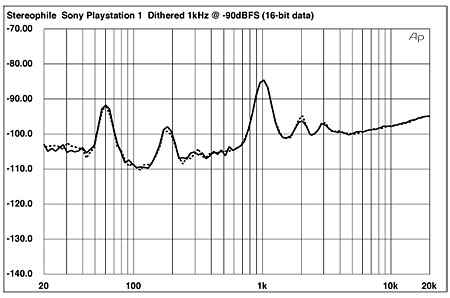| Columns Retired Columns & Blogs |
Does the PS2 or PS2 slim make as good a CD player?
The sample of the Sony PlayStation 1 I measured was the one John Marks had written about in the April 2008 issue (p.57). Unfortunately, this sample, serial number SCPH-1001 U7163475, was destroyed by UPS when I shipped it to Art Dudley. This was a first-generation machine, the only model to have the RCA output jacks and the AKM AK4309AVM 16-bit sigma-delta DAC chip. My son Harry has a third-generation PS1, an SCPH-7501, which has the multi-pin A/V output only and a different DAC chip; I measured that sample, but it was very much worse in most respects than the SCPH-1001. I examined the PS1's measured behavior using both our loaner sample of the top-of-the-line Audio Precision SYS2722 system (see the January issue's "As We See It" and www.ap.com) and my vintage Audio Precision System One Dual Domain.
The PS1's maximum output level was the same—1.09V RMS at 1kHz—from its RCA jacks and from its multipin A/V output, this more than 5dB lower than the CD standard's 2V. The source impedance was the same from both sets of outputs, at a fairly high 1100 ohms in the midrange and treble, rising to 1205 ohms at 20Hz. However, while the multipin output preserved absolute polarity, the RCA jacks inverted signal polarity. (The SCPH-7501's multipin output inverted signal polarity, however.) Error correction was superb, the PS1 suffering no glitches in its output until the gaps in the data spiral on the Pierre Verany test CD reached 1.5mm in length.
The PS1's frequency response (fig.1, top pair of traces) revealed excellent channel matching. However, the ripple in the top three octaves indicates an underspecified digital filter, which will tend to smear time-domain information. The lower pair of traces in fig.1 show the response with pre-emphasized data; it is commendably identical to that with normal data. Channel separation (not shown) is better than 90dB in both directions below 1kHz, but decreases to 72dB at the top of the audioband.

Fig.1 Sony PlayStation 1, frequency response at –12dBFS into 100k ohms, CD data, with normal (top) and pre-emphasized data (0.5dB/vertical div., right channel dashed).
To examine the PS1's low-level resolution, I swept a 1/3-octave bandpass filter from 20kHz to 20Hz while it played a dithered 1kHz tone at –90dBFS. The result is shown in fig.2. The peak representing the tone lies at –86dB rather than –90dB, and the peaks at 2 and 3kHz indicate the presence of some low-order harmonic distortion. The peaks at 60 and 180Hz are due to magnetically induced hum from the AC transformer—this behavior was not affected by whether or not the PS1 was plugged into a TV—and the overall noise floor is up to 15dB higher than that of a good inexpensive CD player, such as the Onkyo DX-7555 reviewed by Robert Deutsch in January. The SCPH-7501 showed the same level error but had considerably more low-frequency noise (not shown).

Fig.2 Sony PlayStation 1, 1/3-octave spectrum with noise and spuriae of dithered 1kHz tone at –90dBFS with 16-bit data (right channel dashed).
Peculiarly, the linearity error (fig.3), assessed with a 500Hz tone, suggested even worse low-level performance than that shown in fig.2, while the PS1's reproduction of an undithered tone at exactly –90.31dBFS was obscured by noise (fig.4; again, see the Onkyo DX-7555's measurements for an example of what this waveform should look like). Overall, it looks as if the first-generation PS1 offers around 14-bit resolution.

Fig.3 Sony PlayStation 1, left-channel departure from linearity, CD data (2dB/vertical div.).

Fig.4 Sony PlayStation 1, waveform of undithered 1kHz sinewave at –90.31dBFS, 16-bit data.
The PS1's output clipped asymmetrically driving full-scale audio into loads lower than 3k ohms or so. But it was happy driving loads greater than that. While some harmonic-distortion components can be seen in the spectrum of the PS1's output driving a 1kHz tone at 0dBFS into 100k ohms (fig.5), these are fairly low in level and are the subjectively innocuous second and third harmonics. However, the noise floor in this graph is again higher than that of a good budget-priced CD player, and is also rather granular in appearance. Intermodulation distortion is low (fig.6), but with a fairly high alias component visible at 23.9kHz as well as the highish noise floor.

Fig.5 Sony PlayStation 1, spectrum of 1kHz sinewave at 0dBFS into 100k ohms (blue left, red right; linear frequency scale).

Fig.6 Sony PlayStation 1, HF intermodulation spectrum, 19+20kHz at 0dBFS peak into 100k ohms (blue left, red right; linear frequency scale).
Tested with the Dunn-Miller diagnostic signal, the PS1 offered moderate rejection of word-clock jitter, at 737 picoseconds peak–peak. The spectrum of the player's output while it decoded the test signal is shown in fig.7; most of the jitter comes from a pair of sidebands at the data-related frequencies of 11.025kHz, ±230Hz, and the AC supply–related frequencies of ±60Hz.

Fig.7 Sony PlayStation 1, high-resolution jitter spectrum of analog output signal (11.025kHz at –6dBFS, sampled at 44.1kHz with LSB toggled at 229Hz), 16-bit CD data). Center frequency of trace, 11.025kHz; frequency range, ±3.5kHz.
Overall, this is a pretty poor set of measurements. I wonder, therefore, if the "magic" of the PlayStation 1's sound lies not in its technical excellence but in the fact that it smears over and disguises much of what is wrong with typical CD sound quality, to which it adds a touch of low-level compression from the linearity error. Certainly, when I recently listened to a PS1 as the source in a system comprising an inexpensive Cayin tube integrated amplifier driving Definitive Technology Mythos ST speakers, it sounded relaxed and informative in a manner I would not have expected from this measured performance.—John Atkinson

Does the PS2 or PS2 slim make as good a CD player?